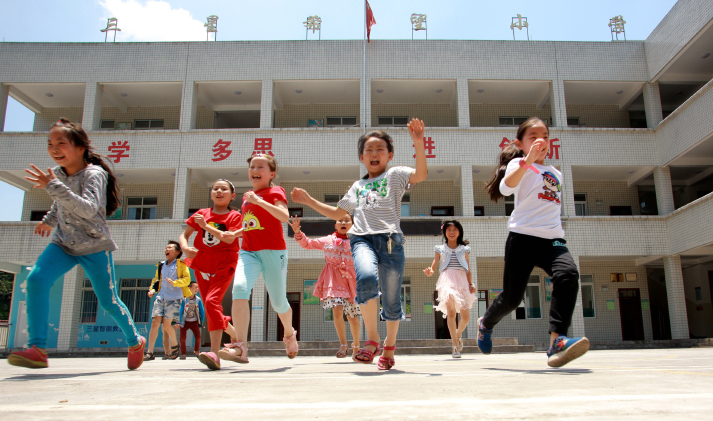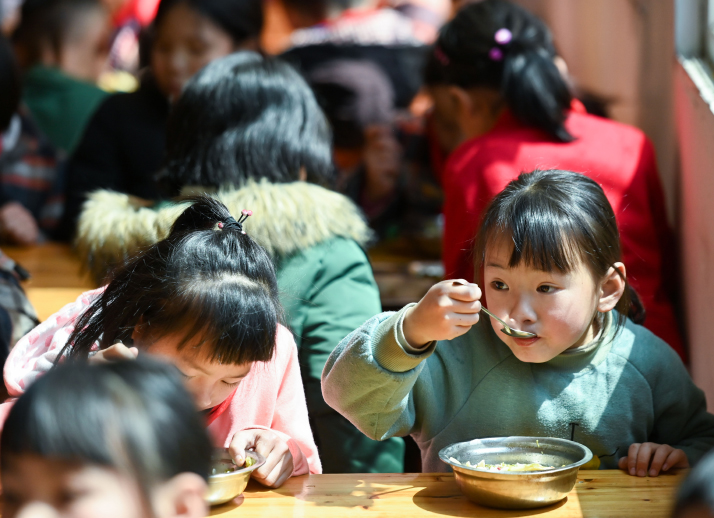|
||||||||||
| Home Nation World Business Opinion Lifestyle ChinAfrica Multimedia Columnists Documents Special Reports |
|
||||||||||
| Home Nation World Business Opinion Lifestyle ChinAfrica Multimedia Columnists Documents Special Reports |
| ChinAfrica |
| Giving Youth Hope |
| Project Hope is helping disadvantaged students access high-quality education nationwide |
| By Xia Yuanyuan | VOL.11 November ·2019-10-25 |

Students in Jiajiang County Samsung Hope Primary School in southwest China's Sichuan Province play after class (XINHUA)
Late Secretary General of the United Nations Kofi Annan famously said, "Knowledge is power. Information is liberating. Education is the premise of progress, in every society, in every family."
In China, this sentiment certainly rings true. Society and families place great value on education. In particular, the country has been making great efforts to improve education for children in rural and remote mountainous regions, which are usually hit by poverty. Schooling is widely believed to be the best way to empower the youth, who are seen as the hope of their families to rise out of poverty.
To achieve this goal, 30 years ago, China Youth Development Foundation (CYDF), a nationwide public foundation registered at the Ministry of Civil Affairs, announced to launch Project Hope. The aim is to raise much-needed funds for the improvement of educational conditions in China's impoverished areas and promote youth development in China.
As of 2018, Project Hope has accumulatively raised over 15 billion yuan ($2.14 billion), aided over 5.9 million financially-challenged rural students (including primary, secondary and college students) and built 20,110 Hope Primary Schools, about 31,109 Project Hope Mini Libraries and 6,236 Hope Kitchens.
A survey by the Social Survey Center of China Youth Daily shows that 93.9 percent of Chinese urban citizens aged 16 and above know about Project Hope, and 63.5 percent have participated in the project in a wide variety of ways. As one of the most extensive, influential and widely participated philanthropic programs in China, the project has experienced two major stages of development in the past 30 years.

Students in Zhixing Hope Primary School in Taijiang County in southwest China's Guizhou Province have lunch in March (XINHUA)
Before the foundation set up the project, the country was seeing an increasing number of school dropouts in rural areas.
Official statistics at the time showed more than 7.5 million students dropped out of school in 1988, an increase of 34.5 percent over the previous year. From 1980 to 1988, a total of 37 million students quit school, a quarter of whom because of poverty.
After seeing these disturbing figures, the foundation made investigations and decided in October 1989 to establish the country's first program to provide financial aid to poor students to allow them to return to school.
The driving force of the project at the outset was to make sure every child had the opportunity to attend school. Over the past 30 years, each day has seen an average of 500 children from impoverished families receiving financial assistance from the project, according to CYDF. "It brings hope for the children in poor families to have a better upbringing by receiving education," said Li Ning, Former Deputy Secretary General of CYDF.
The year 2006 was a turning point for both Project Hope and China's education reform. From that year, the country has carried out the nine-year compulsory education nationwide and later on implemented the "two exemptions and one subsidy"
policy, which means that all students would be exempt from tuition and other fees during the nine-year compulsory education period, and rural students would receive free textbooks and boarding subsidies if they are from needy families. Since then, the nation's ever troubling school dropout rate has been largely decreased.
Now, the mission of Project Hope has changed from ensuring students go to school to helping those in rural areas receive the same high-quality education as those in cities. At this critical moment of poverty alleviation for China, the importance of talents in future rural revitalization cannot be overestimated. High-quality all-round education takes the lead in shaking off poverty and tackling difficulties, said Li.
To achieve the new mission, Project Hope has trained nearly 114,306 rural primary school teachers, and provided Happy Sports Playgrounds, Happy Music Classrooms, Happy Art Classrooms, Computer Labs and Happy Cinema Projection Equipment to promote the comprehensive development of education in poverty-stricken areas.
(Comments to xyy@chinafrica.cn)
|
||||||||||||
| About Us | Contact Us | Advertise with Us | Subscribe |
| Copyright Beijing Review All rights reserved 京ICP备08005356号-5 京公网安备110102005860号 |